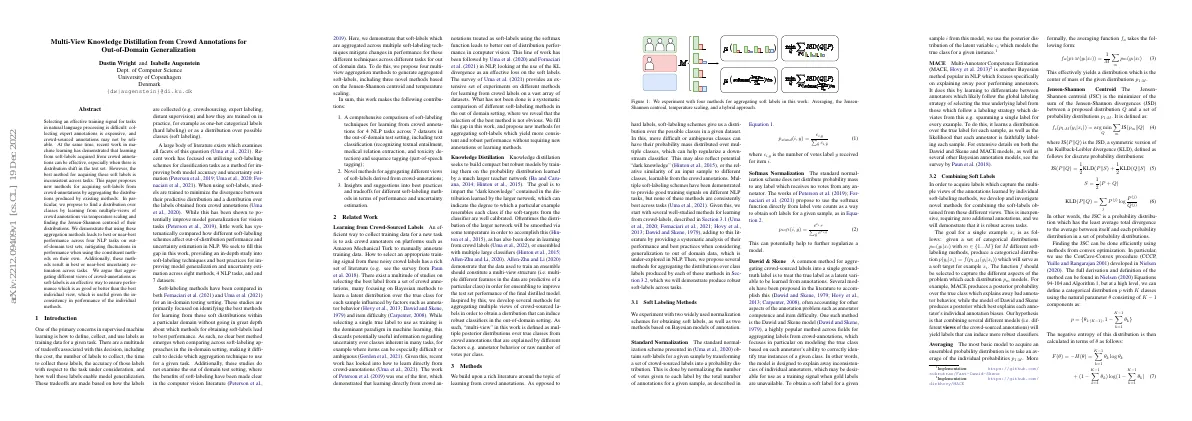Link to paper
The full paper is available here.
You can also find the paper on PapersWithCode here.
Abstract
- Difficult to select effective training signal for natural language processing tasks
- Expert annotations expensive, crowd-sourced annotations may not be reliable
- Recent work in machine learning shows learning from soft-labels acquired from crowd annotations can be effective
- Proposes new methods for acquiring soft-labels from crowd-annotations by aggregating distributions
- Results in best or near-best performance and uncertainty estimation across tasks
Paper Content
Introduction
- Supervised machine learning requires labels as training data
- Tradeoffs exist when deciding how to collect and use labels
- Recent work has focused on soft-labeling schemes to improve accuracy and uncertainty estimation
- Little work has compared how different soft-labeling schemes affect out-of-distribution performance and uncertainty estimation in NLP
- This paper seeks to fill this gap by providing an in-depth study into soft-labeling techniques
- It proposes four multiview aggregation methods to generate aggregated soft-labels
- It also looks at knowledge distillation to build compact but robust models
- It uses multi-view structure to improve test set performance of the final distilled model
Methods
- Learning from crowd annotations is a topic with a rich literature.
- Soft-labeling schemes provide a distribution over possible classes in a dataset.
- Soft-labeling schemes can help regularize a downstream classifier.
- Multiple soft-labeling schemes have been demonstrated to provide good training signals on different NLP tasks.
- This paper provides a systematic analysis of performance and best practices when considering generalization to out of domain data.
- This paper proposes several methods for aggregating the distributions over class labels.
Soft labeling methods
- Standard normalization scheme transforms crowd-sourced labels into a probability distribution
- Softmax function used to obtain soft labels
- Dawid & Skene model used to aggregate crowd-sourced labels into a single groundtruth label
- Model designed to explain away inconsistencies of individual annotators
Combining soft labels
- Acquire labels that capture multiple views of annotations
- Combine soft-labels from different views
- Inexpensive, requires no additional annotations
- Goal is to produce a categorical distribution from a set of distributions
- Averaging is the most basic model
- Centroid is the minimizer of the sum of Jensen-Shannon divergences
- Temperature scaling softens each distribution
- Hybrid approach combines temperature scaling and centroid
Learning from soft labels
- Learning from soft labels requires minimizing divergence between classifier probability distribution and label distribution
- Kullback-Leibler divergence used as loss function between classifier probability distribution and soft labels from Sections 3.1 and 3.2
Experimental setup
- Focus experiments on 3 research questions related to learning from crowd-sourced labels
- Experiments focus on out-of-domain setting with distribution shift between training and test data
- Use RoBERTa as base network with same training hyperparameters
- Experiments measure impact of crowd-sourced soft targets on model generalization
- Tasks include recognizing textual entailment, relation extraction, part-of-speech tagging, and toxicity detection
- Training datasets include Pascal RTE-1, MRE, Gimpel, and Google Jigsaw
- Test datasets include SNLI, causal claim-strength, Penn Treebank POS, and Civil Comments
Results and discussion
- Evaluated performance of soft-labeling methods using two metrics: F1 score and calibrated log-likelihood
- Compared methods using calibrated log-likelihood to obtain fair comparison
- Showed average performance of individual methods and results using only expert annotations and majority vote
Raw performance
- RTE and MRE datasets are difficult to generalize from
- Gold labels yield worse performance than soft labels in out-of-domain setting
- POS tagging sees best performance with gold labels
- Toxicity task benefits from both gold and crowd labels
- Aggregation methods consistently perform better than individual soft-labeling methods
- Adding gold labels for RTE and MRE tasks leads to worse performance
Uncertainty estimation
- Uncertainty estimation can be improved with the addition of soft-labels, except for POS tagging.
- Benefits are more pronounced for RTE and MRE tasks.
- JSC aggregation method provides most consistent results across tasks.
- Hybrid method offers good uncertainty estimation, especially in large-data regime.
- Including gold labels yields better uncertainty estimation when labeled data is abundant.
Research questions
- Performance of individual soft-labeling techniques is inconsistent in out-of-domain setting.
- Aggregating soft-labels can improve performance.
- Aggregating with JSC leads to best or near-best performance.
- Aggregating across soft-labeling methods using JSC is consistently high performing.
- Different individual soft-labeling methods are inconsistent in their uncertainty estimation.
- Aggregating these different views of the crowd-sourced labels mitigates these fluctuations.
- Jenson-Shannon centroid is a sensible and consistent choice across tasks.
Analysis
- JSD of aggregation methods compared to individual methods
- Statistically significant correlation between performance and JSD for RTE dataset
- JSC aggregation method produces distributions closer to hubs of ensemble
- JSC aggregation method may ignore divergent views of data
Conclusion
- Systematic comparison of soft-labeling techniques from crowd-sourced labels
- Out-of-domain setting allows for generalization to unseen data
- Four novel methods for aggregating multiple views of crowd-sourced labels
- JSC yields consistently high raw performance and good uncertainty estimation
